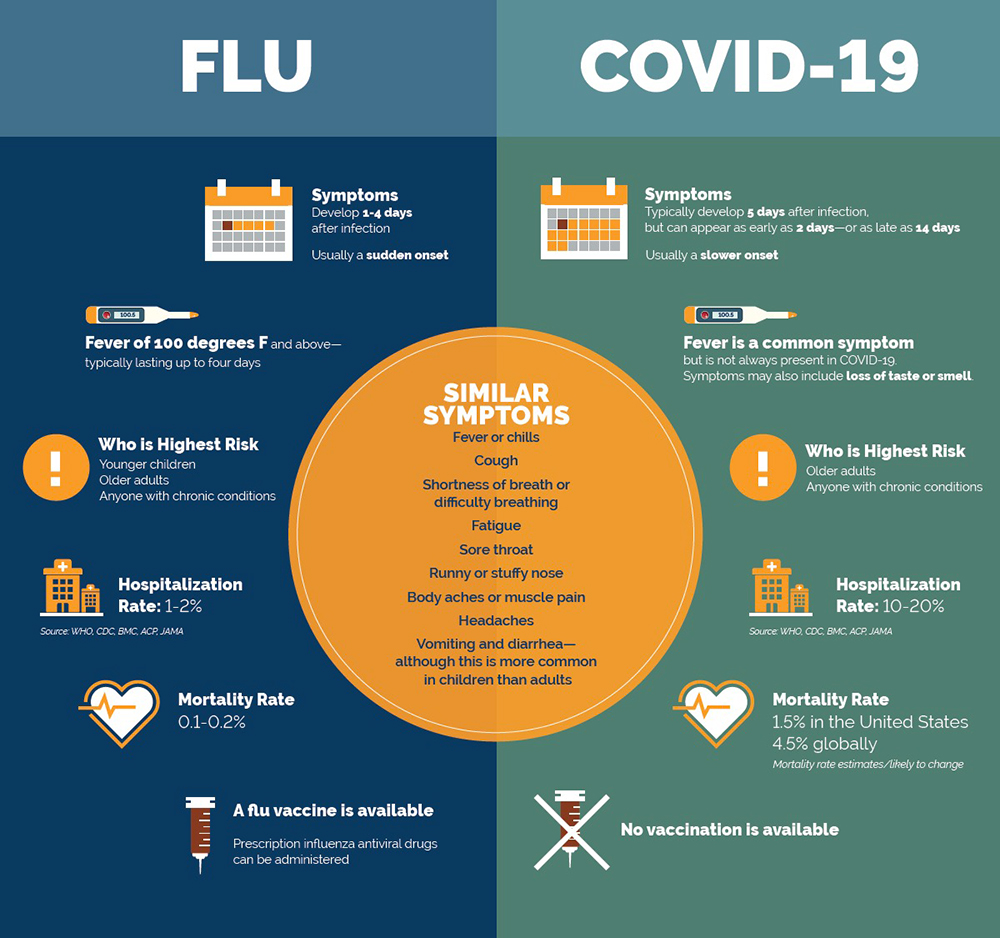Blog
Influenza or COVID-19: How to differentiate between the two
October 27, 2020
The flu season—now upon us—is inevitable each year. Unfortunately, as the world is still managing the novel coronavirus (COVID-19) pandemic, we now have two contagious respiratory illnesses to navigate. And while COVID-19 and influenza (the flu) are not the same, they share similarities that make it challenging to distinguish between the two viruses.
Both the flu and COVID-19 are contagious respiratory illnesses transmitted through respiratory droplets. Each has degrees of severity—and symptoms—that vary per person. Some people experience mild symptoms, or are even asymptomatic, and show no symptoms at all of either virus. For others, symptoms are more severe and recovery time at home is necessary until fevers, coughs and symptoms subside. And, for some, the virus is so severe that advanced medical attention, hospitalization and even death can occur.
The fast rate at which COVID-19 spreads is something that has made this virus particularly newsworthy—and dangerous—in 2020. Additionally, there are no vaccinations or medical protocols to help with COVID-19; it is truly a novel, or new, virus. Researchers and scientists need time to study and develop a vaccination and treatments to treat and protect the public from COVID-19.
Conversely, the flu has been around for decades and is treatable with tested and known medical protocols. Also, each year a new vaccine is formulated, combining science from previous strains, to create a flu shot that serves to help people from both catching—and spreading—the illness that has been monitored and studied for nearly a century.
The only true way to confirm a diagnosis between COVID-19 and influenza is through testing; but here are some similarities—and differences—to watch for.
SIMILAR SYMPTOMS:
- Fever or chills
- Cough
- Shortness of breath or difficulty breathing
- Fatigue
- Sore throat
- Runny or stuffy nose
- Body aches or muscle pain
- Headaches
- Vomiting and diarrhea—although this is more common in children than adults
FLU:
- Symptoms develop 1 to 4 days after infection
- Usually a sudden onset
- Fever of 100 degrees F and above—typically lasting up to four days
- Younger children, older adults and those with chronic conditions are at the highest risk
- Recovery ranges from a few days to less than two weeks
- Hospitalization rate: 1 to 2%
- Mortality rate is 0.1 to 0.2%
- Prescription influenza antiviral drugs can be administered
- A flu vaccine is available
COVID-19:
Symptoms typically develop 5 days after being infected, but symptoms can appear as early as 2 days—or as late as 14 days after being infected—and time range can vary.
- Usually slower onset
- May include loss of taste or smell
- Contagious for about two days before symptoms appear—and up to 10 days after a positive test
- Older adults and people with chronic conditions are most at risk
- Hospitalization rate is 10 to 20%
- Mortality rate estimates/likely to change: 1.5% in the United States and 4.5% globally
- No vaccination is available
FREQUENTLY ASKED QUESTIONS
Is it possible to get COVID-19 and influenza at the same time?
Yes. It’s possible, and could create a serious strain on your system should you contract both viruses concurrently. That’s why it’s important to prepare for both illnesses. Remain diligent with frequent handwashing, sanitizing common surfaces, avoiding crowds, social distancing and wearing a mask to protect yourself—and others—from the spread of COVID-19 (such practices are also helpful to avoid the flu, common colds and other illnesses).
To best avoid the flu, a flu shot is still the best defense. Each year, a new vaccine is created to fight the strains that will most likely be prevalent during that particular season. People have been getting flu vaccinations for almost 80 years and they’ve proven to be highly effective as a safeguard from getting influenza, or from experiencing a severe case if exposed to the virus.
What makes COVID-19 so different than other viruses?
COVID-19 is caused by a novel—or new—coronavirus called SARS-CoV-2. The key word is new. Our bodies have never experienced this type of coronavirus, which means that there are no antibodies to fight it. COVID-19 also has an unusually accelerated rate at which it spreads, making it even more dangerous than the flu, from both a contagion perspective, and because there are no remedies or vaccinations, yet. Scientists and researchers are working on a vaccine and are hopeful to find one soon.
What’s the best thing I can do to help keep myself—and my family—safe?
Get a flu shot. The Centers for Disease Control and Prevention (CDC) urges everyone to get a flu shot, especially during the COVID-19 pandemic, when it’s more important than ever to stay healthy, and protect yourself and those around you. According to the CDC, a flu shot makes you up to 60% less likely to get the flu, and even if you get the virus, it can greatly reduce the severity of your symptoms and reduce the need for medical attention or hospitalization.
Can a flu shot prevent COVID-19?
No. However, a flu shot is still highly recommended because it is possible to get both COVID-19 and influenza at the same time, which could increase the risk of very severe complications.
If you’re able to recover at home with symptoms that may be influenza or COVID-19, please do so. If you need medical attention, don’t hesitate to call EBCH for assistance; our staff will help you determine if you need to get tested for either COVID-19 or influenza.
